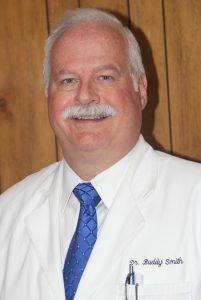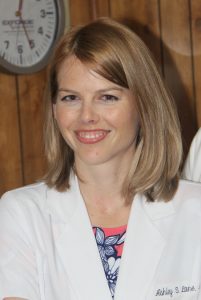It’s all about Timing with Dyrc Sibrans, M.D.
DECATUR — Dyrc Sibrans, M.D., still greets patients with a firm handshake and a friendly smile. His laughter is infectious and easily fills the room as he reminisces about what he’s accomplished during his career. Already retired once from his own thriving medical practice in Decatur in 2000, he originally prepared to spend more time with his wife at a fishing cabin they purchased in Montana, but something just wasn’t quite right. It was all about timing.
“The personal relationships you build with your patients is what’s so special to me,” Dr. Sibrans said. “I thought that it was probably time for me to get out. We bought the place in Montana in 1998, and went out there after I retired in 2001. I had a stack of books on one side of my chair that kept me in that chair until I had read them all and moved them from that side of the chair to the other side! I never had time before to read just for fun until I retired.”
The allure of Big Sky country was more than just reading for Dr. Sibrans. He’s an avid fly fisherman, and with miles and miles of streams awaiting him, the Alabama rheumatologist actually felt right at home…for a little while. But, as with most who answer a calling in their lives, the first retirement never quite sticks. So, when he was asked to review a few charts for a small community free clinic back home, he happily obliged. It wasn’t long before those few chart reviews became to mean much more to him and to the Community Free Clinic of Decatur-Morgan County. Today, Dr. Sibrans serves as the clinic’s medical director.
The Community Free Clinic of Decatur-Morgan County opened in 2004 and provides free medical care, dental care and prescription medication for low-income residents of Morgan County. Staffed by a handful of full-time employees, the medical staff are all volunteers and has expanded to care for more than 3,000 patients annually.
“I did some chart reviews here when the clinic first started, and they needed a physician to help review the charts that the nurse practitioners had done during the day. We had about three or four of us doing that in the beginning. We average about 20 patients a night, and we do clinic two days a week. That’s a lot. Occasionally we have about three or four doctors that will come in after they have closed their practice, and we’ll finish up the night together. We get here about 4 p.m., and we go until we get finished, but we aren’t the ones who have the long days. The ladies in the office have the long days. They stay a lot longer than we do because they have to do all the paperwork,” Dr. Sibrans explained.
The difficult part is to continue to recruit physicians willing to volunteer. The clinic does not take walk-in patients, and there is a screening process. Patients are seen at times when most working physicians have just closed their practices for the day, this makes it difficult for some physicians to come to the Clinic and work three additional hours.
“I do interviews mainly to get some more doctors to come in and volunteer. I think it is a privilege as medical professionals to volunteer. I think it is our responsibility to the community to, in some way, give back to the people who gave so much to us,” Dr. Sibrans said. “When the clinic first opened, they had a lot of physicians who would come in and volunteer. But, over the years, they began to drift away and things got worse. I was doing the chart reviews and noticed there were just a few people doing a lot of the work. Pretty soon I was asked to be fully on board.”
Early on in Dr. Sibrans’ career, he made a critical choice about his career…a choice which could have landed him far outside the path of medicine.
“I have some questions about some of the things I have done in my life, but becoming a physician is definitely not one of them. I truly enjoy it. I knew when I was in high school that I was either going to be a priest or a doctor. I went to the seminary and realized that maybe the celibate life maybe wasn’t the life for me!” Dr. Sibrans laughed. “So, I answered a different calling, and I do consider medicine my true vocation. I had already made up my mind that medicine was what I was going to do. I was a late bloomer. I didn’t really get going in academics until my senior year in high school. Most kids now have to start making great grades in high school. I was very lucky. I got into medicine long before the control by the federal government and insurance companies. The demands that you have to be automated now, it just takes too much time to do what you need to do, and that’s to simply treat your patient. The practice of medicine has become way too difficult these days.”
As a battalion surgeon with the 173rd Airborne Brigade, Dr. Sibrans was part of the Battle of Dak To at the beginning of the Tet Offensive, a nasty battle lasting 19 days and killing 376 U.S. soldiers. He was wounded himself during this battle. Even though he spent much of his time mending his fellow soldiers after battle, Dr. Sibrans found time to render aid to a Montagnard hospital in the highlands not far from his camp.
“Later, we were at a relatively benign base doing protection services. At that time, I was just doing sick call that could mostly be taken care of with antibiotics or cough syrup. I asked for permission to go to that hospital to help out. They were operating on anyone who came in. I saw stuff there that I hadn’t seen since Tropical Medicine in medical school. It was fascinating! All sorts of stuff that I had only read about and never seen again. One day a leper came in, and he was sent on to the leper colony a few miles away that was run by French nuns. I’d never seen anything like that, so I went to volunteer any way I could. I only went twice. Apparently some Viet Cong came into the colony looking for someone. I don’t think they were looking for me. I think they were looking for a Montagnard chief, but our intelligence people found out, and I couldn’t go back. I contacted my wife stateside who got in touch with some drug companies who donated some medicine back to the colony several times. That was such an eye-opening experience. I don’t know that I did that much good, but I know I learned a lot. I tell you what, the training I had at the University of Alabama, and the time I spent at the ER and in the VA, I felt like there wasn’t much I couldn’t handle for at least a little while,” Dr. Sibrans said.
With a lifetime of medicine and volunteerism under his belt, Dr. Sibrans is getting ready to retire…again…at the end of the year. There will be more time for family, reading, fly fishing and his many other hobbies, but when he talks about retiring there’s a bit of a twinkle in his eye.
“It took me a long time to decide to retire. It’s like an old saying I heard a long time ago in medical school that if you’re thinking about doing a tracheostomy, then you should have already done it. So, if I was thinking about retiring, I probably should have already retired!” Dr. Sibrans laughed.
For more information about the Community Free Clinic of Decatur-Morgan County or to become a volunteer, please contact Executive Director Jessica Payne at (256) 309-2491.
Posted in: Physicians Giving Back
Leave a Comment (0) →



 Patriarch George Smith Sr., M.D., graduated from Howard College with a Bachelor’s degree in Pharmacy and worked for three years with Eli Lilly as a pharmaceutical representative, but something was missing.
Patriarch George Smith Sr., M.D., graduated from Howard College with a Bachelor’s degree in Pharmacy and worked for three years with Eli Lilly as a pharmaceutical representative, but something was missing. “I grew up going on house calls with Daddy, carrying his doctor’s bag. He did a lot of house calls in the 60s and 70s, and I was impressed with how people treated my father, how he was respected by his patients and the community. There’s a reason why he’s Dr. Smith and I’m Dr. Buddy. There’s only one Dr. Smith. He’s a legend,” Dr. Buddy said.
“I grew up going on house calls with Daddy, carrying his doctor’s bag. He did a lot of house calls in the 60s and 70s, and I was impressed with how people treated my father, how he was respected by his patients and the community. There’s a reason why he’s Dr. Smith and I’m Dr. Buddy. There’s only one Dr. Smith. He’s a legend,” Dr. Buddy said. “I grew up here and already knew a lot of the people,” Dr. Lane said. “This is a great, established practice, and having these two, amazing mentors during a time when medicine is changing so quickly definitely makes being a young practicing physician a bit easier.”
“I grew up here and already knew a lot of the people,” Dr. Lane said. “This is a great, established practice, and having these two, amazing mentors during a time when medicine is changing so quickly definitely makes being a young practicing physician a bit easier.”

